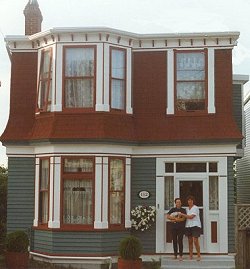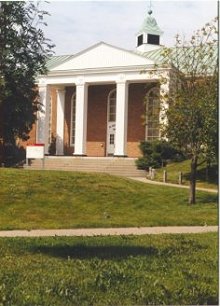

Hands Across the Sea
Historical links between the two regions --: Are you aware that practically all of the relatives of Irish Newfoundlanders came from Waterford,Wexford, Kilkenny area in Ireland. The accent of downtown St. John's today is said to sound like that of a Waterford accent in Ireland. Mr. O'Neachtain told us that he thought the accent in some parts of Newfoundland was very like a Wexford accent. We watched a video about the people in Newfoundland made by RTE television about twenty five years ago called "The Forgotten Irish" . Brother Murphy who visited us had a strange accent. He even says "Well. boy", which is what you would hear in Waterford Ireland.You would not think that the people were from Canada. Irish music is very popular over there as well. Irishmen went over there on fishing boats from the 17th century onwards to prosecute the salt cod-fishing industry.
 It would have
taken about two months to sail over there in them days. The water around Newfoundland is
freezing and fishing was a tough life as you had to pull in the nets by hand.They were
tough men in them days.Waterford businessmen like John Kent, the second Prime
Minister of Newfoundland, and who established businesses at St. John's,arranged ships that
brought thousands of Waterford people across the Atlantic to Newfoundland.
First only the men went during the fishing season but they got fed up making the long
journey back and forth across the Typical house in St. John's
It would have
taken about two months to sail over there in them days. The water around Newfoundland is
freezing and fishing was a tough life as you had to pull in the nets by hand.They were
tough men in them days.Waterford businessmen like John Kent, the second Prime
Minister of Newfoundland, and who established businesses at St. John's,arranged ships that
brought thousands of Waterford people across the Atlantic to Newfoundland.
First only the men went during the fishing season but they got fed up making the long
journey back and forth across the Typical house in St. John's
Atlantic so they then brought over their families and they settled in small fishing
villages around the coast of the island. They brought with them their customs, their music
and songs , which remain on the island to this very day.
Another Waterford businessman named, Sweetman, who also ran a business at Placentia, Newfoundland in the last century, transported several thousand Irish people from Waterford and surrounding area to the Placentia-St. Mary's Bay areas. In fact, the connection between St. John's and Waterford, Ireland was so strong that many parents of Irish origin, though their children were baptised at St. John's had them entered into the records of St. Patrick's Church, Waterford, Ireland.
 There are three large rivers entering the sea at or near Waterford,
Ireland. These rivers are known as "the three sisters. the river are the Nore,
The Suir and the Barrow. It is said that young fellows hoping to take the sailing ships
from Waterford to St. John's floated down these rivers on rafts or boats.The Waterford
settlers referred to those here from Wexford as "the Wexford Yellow Bellies." .
The Irish represent about one-third of the people of the province, have relatives who for
the most part came from Waterford. In fact, the main valley and river flowing into St.
John's Harbour, are: Waterford Valley and Waterford River.Even the "nut
house" or mental hospital Memorial University St. John's of St. John's is officially called the "
Waterford Hospital for nervous diseases".
There are three large rivers entering the sea at or near Waterford,
Ireland. These rivers are known as "the three sisters. the river are the Nore,
The Suir and the Barrow. It is said that young fellows hoping to take the sailing ships
from Waterford to St. John's floated down these rivers on rafts or boats.The Waterford
settlers referred to those here from Wexford as "the Wexford Yellow Bellies." .
The Irish represent about one-third of the people of the province, have relatives who for
the most part came from Waterford. In fact, the main valley and river flowing into St.
John's Harbour, are: Waterford Valley and Waterford River.Even the "nut
house" or mental hospital Memorial University St. John's of St. John's is officially called the "
Waterford Hospital for nervous diseases".
The English merchants travelling to Newfoundland normally called to Waterford, on their way to fish off The Grand Banks of Newfoundland and along the coasts of Newfoundland and Labrador. At Waterford, these merchants had warehouses and took on supplies before crossing under sail, the Atlantic Ocean every May or June.Jacob's,famous in Ireland for their biscuits set up their first factory in waterford. They made their money from developing a special "Ship's biscuit" which would not go soft on a long voyage.
There were Waterford merchants engaged in the fishery too. John Kent is said to have brought several thousand Irishmen to St. John's as immigrants. He had businesses at Waterford and at St. John's simultaneously. John Kent was the second Prime Minister of Newfoundland which received representative government in 1834 and Responsible Government in 1855. He was impeached by Governor Hoyles, an embittered English bureaucrat not willing to have a Roman Catholic P.M., here. Another Anglo-Irish Waterford merchant, Sweetland, brought about 3,000 Irish immigrants to Placentia, Newfoundland to settle there after the French had been driven out. Placentia, roughly 75 miles from St. John's was the old French capital of Newfoundland in the 17th century.
Now, through the internet, people from St. John's are communicating with people in Waterford. Long may it continue
Miley Flynn and Robert Lonergan
Special Thanks to Michael and
Alexa Laurie, Bell Island , Newfoundland, Canada for helping us put this section together.